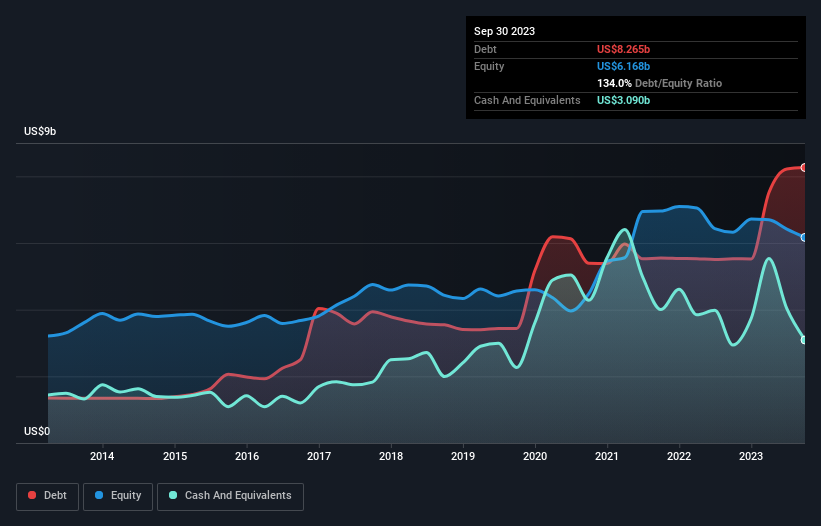
Warren Buffett famously said, 'Volatility is far from synonymous with risk.' When we think about how risky a company is, we always like to look at its use of debt, since debt overload can lead to ruin. We can see that The Estée Lauder Companies Inc. (NYSE:EL) does use debt in its business. But the more important question is: how much risk is that debt creating?
When Is Debt A Problem?
Debt assists a business until the business has trouble paying it off, either with new capital or with free cash flow. If things get really bad, the lenders can take control of the business. While that is not too common, we often do see indebted companies permanently diluting shareholders because lenders force them to raise capital at a distressed price. By replacing dilution, though, debt can be an extremely good tool for businesses that need capital to invest in growth at high rates of return. The first thing to do when considering how much debt a business uses is to look at its cash and debt together.
See our latest analysis for Estée Lauder Companies
What Is Estée Lauder Companies's Net Debt?
As you can see below, at the end of September 2023, Estée Lauder Companies had US$8.27b of debt, up from US$5.53b a year ago. Click the image for more detail. On the flip side, it has US$3.09b in cash leading to net debt of about US$5.18b.

A Look At Estée Lauder Companies' Liabilities
According to the last reported balance sheet, Estée Lauder Companies had liabilities of US$5.91b due within 12 months, and liabilities of US$10.6b due beyond 12 months. On the other hand, it had cash of US$3.09b and US$1.91b worth of receivables due within a year. So it has liabilities totalling US$11.5b more than its cash and near-term receivables, combined.
While this might seem like a lot, it is not so bad since Estée Lauder Companies has a huge market capitalization of US$52.3b, and so it could probably strengthen its balance sheet by raising capital if it needed to. But we definitely want to keep our eyes open to indications that its debt is bringing too much risk.
In order to size up a company's debt relative to its earnings, we calculate its net debt divided by its earnings before interest, tax, depreciation, and amortization (EBITDA) and its earnings before interest and tax (EBIT) divided by its interest expense (its interest cover). The advantage of this approach is that we take into account both the absolute quantum of debt (with net debt to EBITDA) and the actual interest expenses associated with that debt (with its interest cover ratio).
Estée Lauder Companies has net debt to EBITDA of 2.6 suggesting it uses a fair bit of leverage to boost returns. On the plus side, its EBIT was 8.2 times its interest expense, and its net debt to EBITDA, was quite high, at 2.6. Importantly, Estée Lauder Companies's EBIT fell a jaw-dropping 62% in the last twelve months. If that earnings trend continues then paying off its debt will be about as easy as herding cats on to a roller coaster. There's no doubt that we learn most about debt from the balance sheet. But ultimately the future profitability of the business will decide if Estée Lauder Companies can strengthen its balance sheet over time. So if you want to see what the professionals think, you might find this free report on analyst profit forecasts to be interesting.
But our final consideration is also important, because a company cannot pay debt with paper profits; it needs cold hard cash. So we always check how much of that EBIT is translated into free cash flow. Looking at the most recent three years, Estée Lauder Companies recorded free cash flow of 33% of its EBIT, which is weaker than we'd expect. That's not great, when it comes to paying down debt.
Our View
Estée Lauder Companies's struggle to grow its EBIT had us second guessing its balance sheet strength, but the other data-points we considered were relatively redeeming. For example, its interest cover is relatively strong. Taking the abovementioned factors together we do think Estée Lauder Companies's debt poses some risks to the business. While that debt can boost returns, we think the company has enough leverage now. The balance sheet is clearly the area to focus on when you are analysing debt. But ultimately, every company can contain risks that exist outside of the balance sheet. For example Estée Lauder Companies has 4 warning signs (and 1 which is concerning) we think you should know about.
At the end of the day, it's often better to focus on companies that are free from net debt. You can access our special list of such companies (all with a track record of profit growth). It's free.
Valuation is complex, but we're here to simplify it.
Discover if Estée Lauder Companies might be undervalued or overvalued with our detailed analysis, featuring fair value estimates, potential risks, dividends, insider trades, and its financial condition.
Access Free AnalysisHave feedback on this article? Concerned about the content? Get in touch with us directly. Alternatively, email editorial-team (at) simplywallst.com.
This article by Simply Wall St is general in nature. We provide commentary based on historical data and analyst forecasts only using an unbiased methodology and our articles are not intended to be financial advice. It does not constitute a recommendation to buy or sell any stock, and does not take account of your objectives, or your financial situation. We aim to bring you long-term focused analysis driven by fundamental data. Note that our analysis may not factor in the latest price-sensitive company announcements or qualitative material. Simply Wall St has no position in any stocks mentioned.
About NYSE:EL
Estée Lauder Companies
Manufactures, markets, and sells skin care, makeup, fragrance, and hair care products worldwide.
Fair value with moderate growth potential.
Similar Companies
Market Insights
Community Narratives




